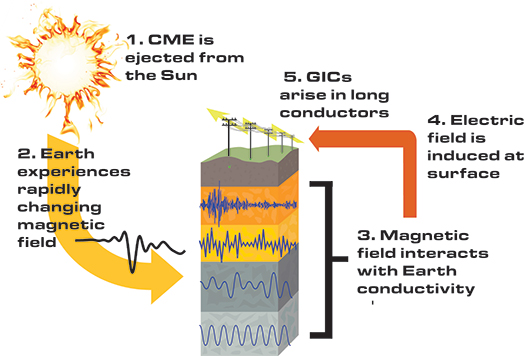Space weather continually affects the earth, as plasma ejected from the sun interacts with the earth’s natural magnetic field. We are often unaware of the geomagnetic storms that occur from month to month, due to solar coronal holes, high-speed streams, and coronal mass ejections. However, these storms regularly impact human society behind the scenes, as rapid and widespread fluctuations in the earth’s magnetic field disrupt polar flights, magnetic guidance, and long-range communications systems. Power systems, in particular, can be significantly affected by space weather.
During a geomagnetic storm, power systems, oil pipelines, and other technologies that use long conductors experience quasi-DC currents called Geomagnetically Induced Currents (GICs). The geo-electric fields that are induced by rapidly fluctuating magnetic fields, interacting with the earth’s geological structures, affect long transmission lines. The extraneous currents that are induced in long transmission lines during periods of active space weather are usually small. However, when a large storm occurs, GICs are enhanced, and significant damage to transformers can occur.
Transformers can be affected by GICs in two ways—through half-cycle saturation and through physical damage to the transformers due to overheating. Half-cycle saturation increases reactive power absorption and can cause an increase in harmonics, which, in extreme cases, may lead to voltage collapse. Overheating can occur when transient fields damage and melt insulators. Recognition of these dangers at the federal and regulatory levels has resulted in a new focus on the science of GICs, and the development of new tools and capabilities for understanding the potential threat. The best risk mitigation plan is to know the geophysical hazard, understand the system response and monitor local conditions.
Which Systems Are at Highest Risk from GICs?
Determination of the risk from GICs is not simple, but there are a few general guidelines that can be used as a starting point. Natural geophysical hazard conditions, as well as transmission system characteristics, both play a role in making a system susceptible to damage from GICs. For example, systems with connections to long, high-voltage transmission lines, three phase transformers, and certain substation grounding parameters can be at increased risk. However, these components are common and the risk can vary greatly between similar systems. This is because the geophysical hazard is primarily based on location. Latitude, geology and the specific features of each unique geomagnetic storm all play a significant role.
High latitude regions are generally at higher risk for GIC effects because that is where the largest fluctuations in the magnetic field often occur during typical geomagnetic storms. The most obvious manifestation of this is the appearance of the aurora, which can be a visual indicator of GIC hazard. Proximity to the ionospheric current systems that produce the aurora greatly increases GIC hazard.
Certain areas of the US have geological conductivity structures that result in higher induced electric fields during a geomagnetic storm and therefore a higher expected level of GICs. This is due to the deep earth geology of a region beneath the substation and transmission lines, which determines the intensity of the induced electric field. These locations have been mapped by federal, academic and private surveys.
Specific storm characteristics can also increase GIC hazard. Since the largest geomagnetic storms are not simply bigger versions of commonly occurring small events, the effects can be hard to predict. For example, during a very large event, the aurora may extend much further towards the equator than expected or the magnetic variation may have higher frequency components than previously experienced. Some storms have different magnetic spectral characteristics and therefore interact differently with geological structures. The direction of the magnetic field, which determines the coupling with the transmission line, fluctuates wildly and unpredictably during large events. So while knowing geophysical conditions is critical to predicting GIC hazard, it is important to remember that each storm is unique, and the largest storms may be drastically different from what has been experienced in the past.
What is the Largest Storm We can Expect?
Although we don’t know exactly what to expect for the largest possible storm, there have been several large recorded events that can provide clues. While not all of these resulted in system damage, studying these past events provides a basis to plan for and mitigate potential damage due to GICs.
The Carrington Event is the largest recorded geomagnetic storm. It occurred in 1859, prior to the widespread use of technological systems we employ today. The solar flare that preceded the ejection of plasma from the sun was so large that it was observed by eye on Earth. Because the time of the flare and the arrival of the coronal mass ejection at Earth were recorded, we know that it moved extremely quickly through interplanetary space. Observations of the magnetic field taken at the Colaba Observatory in India showed an extremely large geomagnetic storm. GICs were induced on long telegraph wires, which, in some cases, operated without power. The Carrington Event, if it happened today, would have a definite impact on power systems, which is why it is often used as a worst-case scenario for planning purposes.
There have been other large events since 1859 that have motivated modern GIC science and engineering efforts. The geomagnetic storm of 1989, even though it was not as large as other events in history, is well known to have caused a wide-scale cascading blackout in the Canadian province of Quebec. The “Halloween” event of 2001 may have caused damage to the South African power grid. Although these events are not as extreme as the Carrington Event, they demonstrate the potential for GICs to affect power systems. We also know, through the benefit of full-time satellite observations of the sun, that there are frequent occurrences of large coronal mass ejections that miss the earth, including a near-miss in 2012. These observations prove the potential for large geomagnetic storms and provide the basis for planning and mitigation strategies
Can Geomagnetic Storms and Impacts Be Predicted?
Some day in the future, space weather might be reliably predicted like terrestrial weather, but for now, we still have a long way to go. Predictive models based on solar wind conditions are becoming more widely available, but are not yet common in operation. The science behind these models is improving as more data and resources become available. The NOAA Space Weather Prediction Center provides alerts of potential for GIC hazard based on satellite observations of the sun, and forecaster analysis. A confirmation of an impending geomagnetic storm may occur approximately 30 minutes ahead of time, based on NOAA solar wind observations. These alerts are useful indicators but must be used in combination with local monitoring and metrics to provide actionable GIC hazard information.
Although we can’t yet predict when or where a large storm will occur, there is much that can be done in planning and operations to prepare for a geomagnetic storm. Several off-the-shelf products are available for GIC analysis and mitigation planning. These require the use of an accurate power system model that uses inputs derived from direct magnetic field measurements or a worst-case hazard scenario to estimate GIC in each line and transformer. This information can be used to model which transformers are most vulnerable, as well as how changes in the system, storm orientation, and storm intensity affect the system vulnerability.

Based on hazard analyses, mitigation strategies and response plans can be implemented and tested. A response plan might incorporate NOAA alerts with local monitoring, and system-specific storm impact metrics. Tools such as local magnetometers or GIC monitors can be placed in critical areas and used in operations to understand GIC conditions as they unfold. Metrics can be developed on a system-by-system basis to estimate GIC levels for different storm conditions. By combining planning studies with available operational tools, the GIC hazard can be well understood.
Recognition of the GIC threat to critical infrastructure has strengthened science and engineering efforts in recent years, but there remain many open questions. As prediction improves and mitigation strategies are formed, there is still much that can be done to prepare for GIC hazard. The keys to successful GIC planning and operations are local and system-specific—know the geophysical hazard, understand the system response, and monitor local conditions.
About the Author
 Jennifer L. Gannon has been studying charged particles and electromagnetic phenomena in near-earth space and the solid earth throughout her scientific career. Gannon served as a scientist at the NOAA Space Environment Center and its successor agency, the NOAA Space Weather Prediction Center, and later as a federal researcher at the U.S. Geological Survey. Moving to the private sector, Gannon co-founded Space Hazards Applications, LLC, of Boulder, Colorado, a consulting firm for space hazards to built infrastructure. Gannon is the author or co-author of many publications in the peer-reviewed literature, as well as several U.S.G.S. Open-file Reports and conference presentations. She received her B.S. from the University of Virginia in 2000 and her Ph.D. from the University of Colorado in 2005. Gannon currently serves in CPI’s Boulder office as geomagnetic disturbance division lead. You can reach her at gannon@cpi.com or 303-442-3992.
Jennifer L. Gannon has been studying charged particles and electromagnetic phenomena in near-earth space and the solid earth throughout her scientific career. Gannon served as a scientist at the NOAA Space Environment Center and its successor agency, the NOAA Space Weather Prediction Center, and later as a federal researcher at the U.S. Geological Survey. Moving to the private sector, Gannon co-founded Space Hazards Applications, LLC, of Boulder, Colorado, a consulting firm for space hazards to built infrastructure. Gannon is the author or co-author of many publications in the peer-reviewed literature, as well as several U.S.G.S. Open-file Reports and conference presentations. She received her B.S. from the University of Virginia in 2000 and her Ph.D. from the University of Colorado in 2005. Gannon currently serves in CPI’s Boulder office as geomagnetic disturbance division lead. You can reach her at gannon@cpi.com or 303-442-3992.







